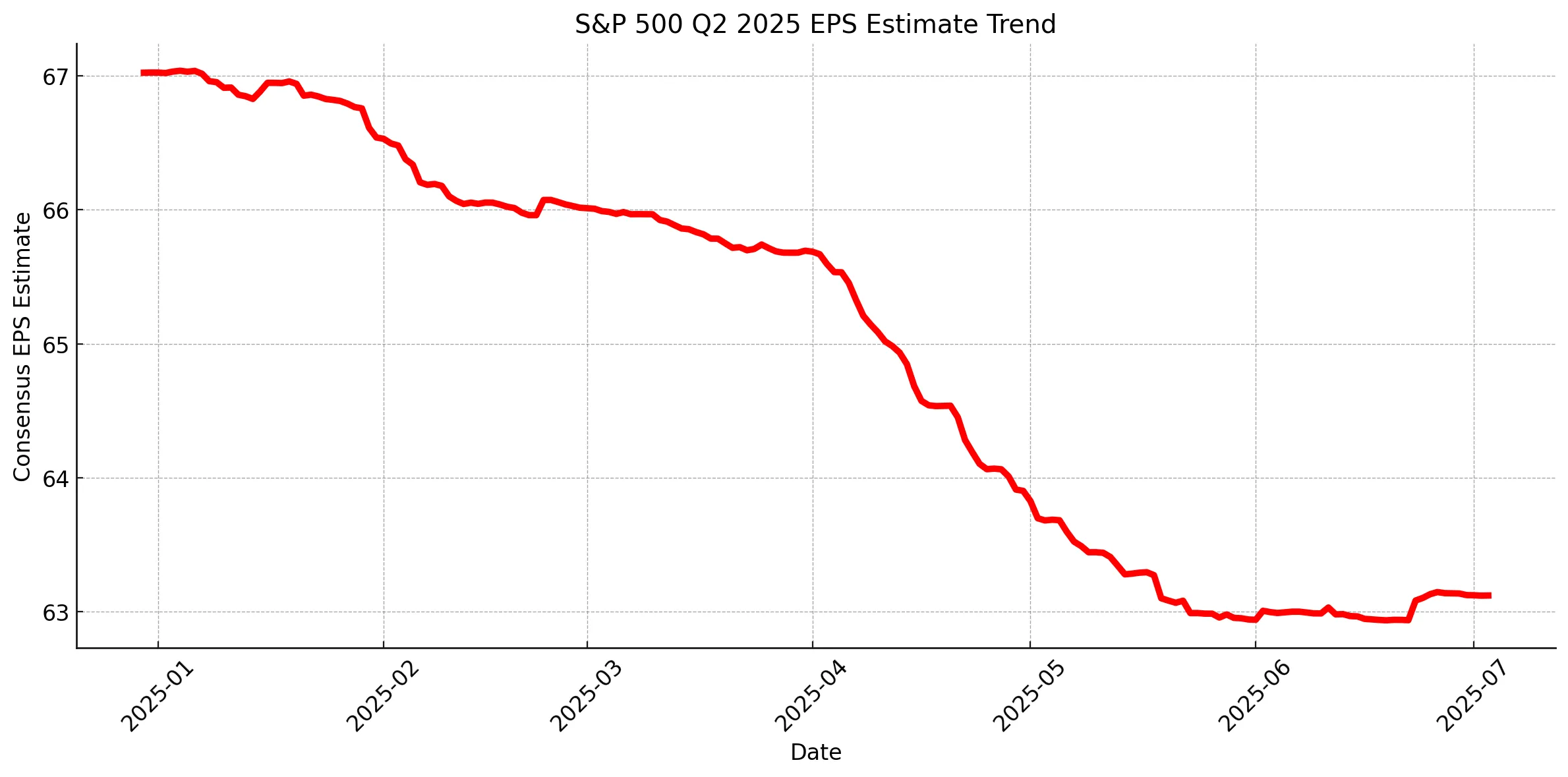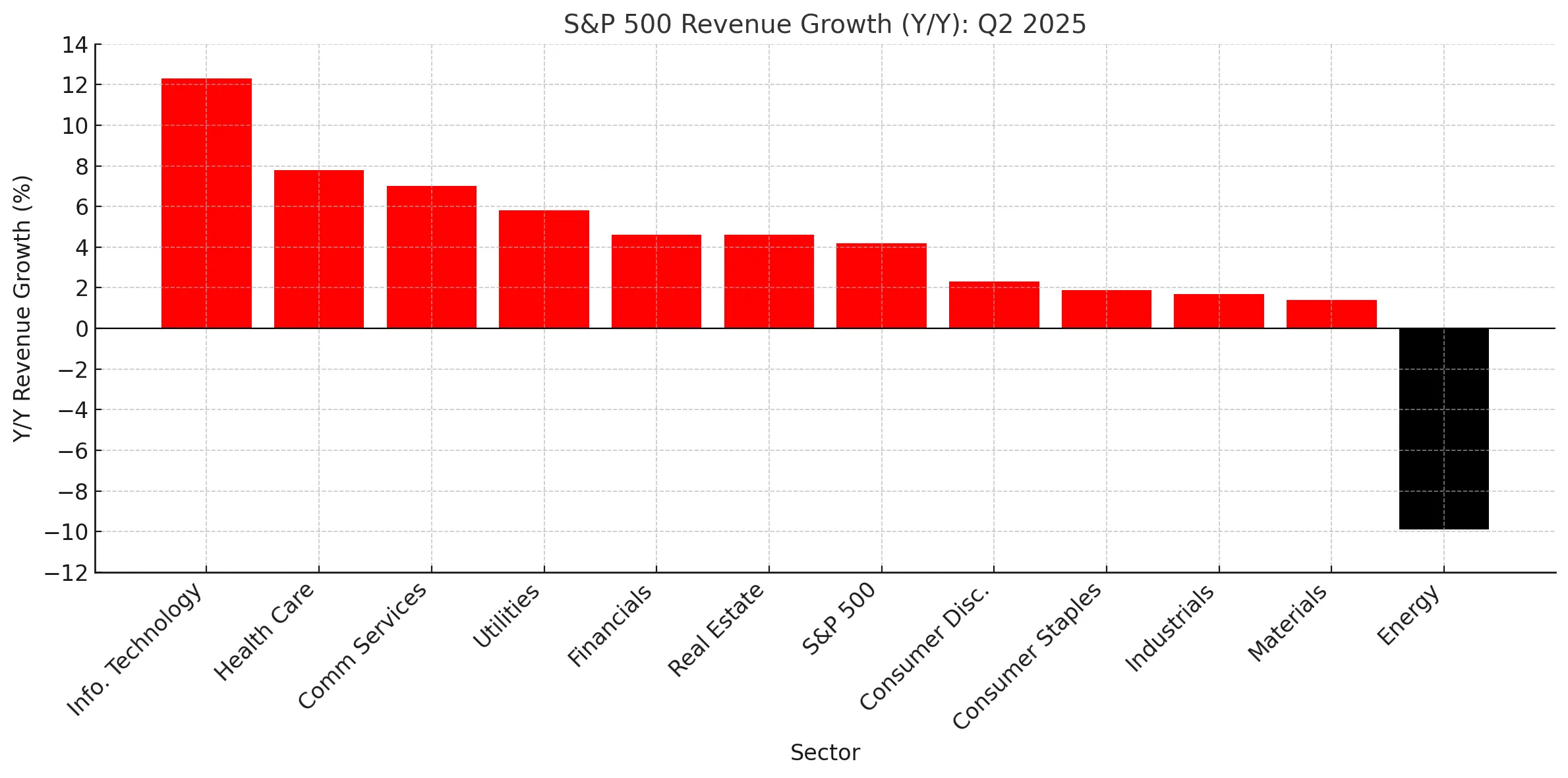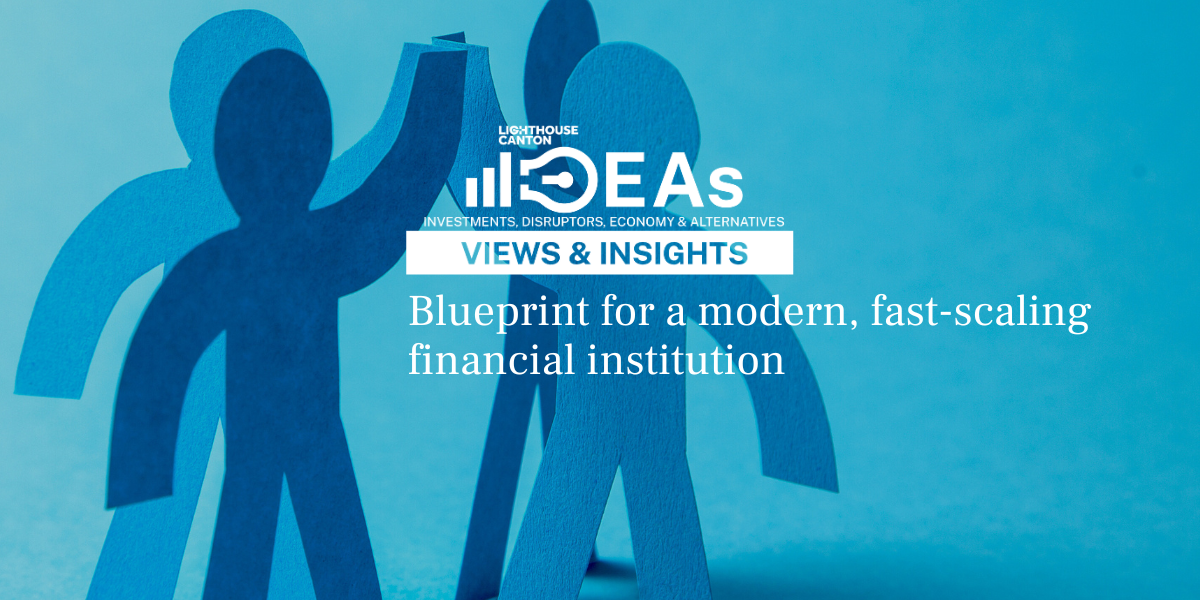Macro Backdrop & Consensus Expectations
As Q2 earnings season begins, consensus estimates suggest ~5.0% year-over-year earnings growth and ~4.2% revenue growth for the S&P 500. This marks a slowdown from Q1 but still reflects resilience across corporate America despite macro uncertainty. Notably, earnings expectations have been revised down significantly from ~12% projected in January, highlighting how cautious companies and analysts have become in light of tightening financial conditions and policy overhangs. Margins remain a critical swing factor—especially as input cost inflation, baseline tariffs, and wage pressures continue to affect corporate P&Ls.

Overall positioning remains constructive, with relatively few negative pre-announcements and continued investor interest in secular growth stories, particularly around AI, infrastructure capex, and healthcare innovation. However, sectoral dispersion remains wide and selectivity is key.
One question increasingly coming into focus at Lighthouse Canton is whether Q1’s upside surprise was partly a function of earnings pull-forwards—whether in demand, capex cycles, or cost optimization. If so, how much of Q2 is still benefiting from those tailwinds, and more importantly, what does that imply for H2 2025? The bar may be low, but forward visibility is murky, and understanding the sustainability of earnings momentum will be critical in shaping positioning from here.


This earnings season is unlikely to deliver fireworks at the index level, but beneath the surface lies rich terrain for relative performance. Leadership is likely to remain concentrated in quality, cash-generative franchises—particularly those with exposure to AI, healthcare innovation, and infrastructure enablement. Sectoral divergence is no longer a theme; it’s the reality. The key for investors now is not to bet on direction, but on dispersion.

Information Technology
No sector has embodied the optimism of 2025 more than Technology. The AI wave continues to fuel demand for compute power, intelligent automation, and secure cloud architecture—cementing the space as the dominant earnings engine for this quarter. Semiconductors, led by Nvidia, remain at the heart of the hardware stack while enterprise software adoption, particularly in AI-enabled workflow tools, continues to broaden. With companies like Microsoft showing momentum in Azure, and ServiceNow pushing further into enterprise AI integration, tech’s outperformance may not be just a phase—it’s structural. Any softness in consumer electronics or device spending may be brushed aside if core infrastructure names continue to deliver.
Health Care
Healthcare is quietly building strength. While not as flashy as tech, the sector offers a stable combination of defensive revenue streams and optionality through innovation. Biotech milestones and the rebound in elective procedures are tailwinds, while large-cap pharma is seeing positive operating leverage. Firms like UnitedHealth and Pfizer offer clarity on reimbursement trends and drug development timelines. As demographic pressures and aging populations drive long-term demand, the sector stands out as a source of durable earnings amidst volatility elsewhere.
Communication Services
A resurgent sector thanks to the return of ad budgets and monetization strength across social platforms. Alphabet is benefiting from a steady recovery in search and YouTube, while Meta continues to fine-tune Reels monetization and cross-platform engagement. The gap between digital-first and legacy telecom players remains wide—with the latter still facing price wars and capex burdens. Investors should focus on platform stickiness, engagement metrics, and commentary on AI-augmented ad delivery.
Consumer Discretionary
It’s a tale of two consumers. On one end, discretionary giants like Amazon continue to demonstrate logistics efficiency and ecosystem stickiness even as households tighten budgets. On the other, the luxury segment continues to struggle. With demand slowing in both the U.S. and China, the two largest end markets, luxury brands are seeing pressure on both volumes and pricing power. While many of these names have corrected meaningfully from their highs and look attractive from a valuation standpoint, a clear positive catalyst is needed to justify entry in the near term.
The broader sector is also feeling the heat from trade dynamics. Apparel and footwear companies, in particular, are grappling with the implications of reciprocal tariffs. Much of the production base remains concentrated in China and Vietnam, and the recently imposed 20% tariffs on Vietnamese-origin goods—stemming from the restructured trade deal—are expected to weigh directly on gross margins. These tariffs are forcing brands to either absorb higher input costs or attempt price passthroughs, which in turn could suppress consumer demand. Margin erosion, coupled with weak volume recovery, makes this a closely watched pocket of the consumer complex.
This quarter will test which brands truly command pricing power and operational flexibility—and which were riding cyclical tailwinds.
Consumer Staples
In a defensive tape, staples are meant to be the stabilizers—and Q2 will show whether that thesis holds. Input cost inflation may be easing, but consumer trade-down behavior is still evident. The market will focus heavily on gross margins and inventory discipline. Giants like Procter & Gamble and PepsiCo will offer important cues on how global brands are navigating cost, demand elasticity, and FX volatility.
Industrials
A sector with clear dispersion. Traditional industrials tied to freight, logistics, and general manufacturing may struggle to beat low expectations due to muted volume growth and input cost friction. However, a new pocket of leadership is emerging: companies aligned with the AI capex cycle. Vertiv, Schneider Electric, and Eaton are increasingly seen as the infrastructure arms race enablers—providing power management, cooling, and electrification systems essential to hyperscaler data center builds. Aerospace continues to see healthy backlogs as global travel demand normalizes.
Materials
While not top-of-mind for many investors, Materials remains a bellwether for global economic momentum. Q2 is expected to be mixed. Companies exposed to construction and specialty chemicals—like Sherwin-Williams and Linde—should benefit from U.S. infrastructure stimulus and downstream manufacturing trends. However, softness from China and FX drag remain headwinds. Look for nuanced commentary around pricing power and margin stability.
Energy
It’s a quarter of reset expectations. With crude and natural gas prices below last year’s peaks, earnings comparisons look tough on paper. But the industry has matured—capex discipline, low breakevens, and aggressive shareholder returns have structurally improved the investment case. ExxonMobil and Chevron will be closely watched for capital deployment strategies, while SLB offers a window into upstream service activity. Any hints of reacceleration in LNG investment could shift sentiment.
Utilities
Utilities are back in the spotlight—not as boring bond proxies, but as enablers of the green transition. Renewable capacity additions, grid modernization, and inflation-linked pricing mechanisms make this sector more dynamic than in previous cycles. Companies like NextEra and Duke Energy are riding this wave, offering visibility into rate-base growth while maintaining defensive cash flow profiles. Expect a quiet but steady earnings season.
Financials
Q2 could be a litmus test for the U.S. banking system. Net interest margins are holding up, but deposit repricing and loan loss provisions are beginning to stir concern. The mega-banks—JPMorgan, Bank of America, Wells Fargo—will shape the narrative. Credit quality in consumer and commercial real estate books is the primary risk to watch. Investment banking and trading desks may offer upside if market volatility stays contained. Regional banks remain under the microscope, with deposit stickiness still in focus.
Real Estate
While office real estate continues to face secular pressure, not all corners of the REIT world are in retreat. Industrial and data center REITs—like Prologis, Equinix, and Digital Realty—stand to benefit from structural digital infrastructure demand. Leasing metrics, occupancy trends, and forward capex commentary will be the key differentiators. In an environment where bond yields remain rangebound, selective real estate exposure could still offer relative value.
Mega-Cap Tech & AI: The Continued Pillar of Strength
The mega-cap tech names—Nvidia, Microsoft, Alphabet, Amazon, and Meta—remain the cornerstone of U.S. equity outperformance. Together, they represent the backbone of AI infrastructure, cloud compute, and digital monetization. As AI workloads continue to scale, these companies are not just selling tools—they are the platforms upon which the next decade of enterprise and consumer innovation will be built.
Q2 will once again be about delivery and tone. The market expects consistency. Commentary on inference vs training demand, AI SaaS monetization, and cloud unit economics will be heavily scrutinized. These firms are priced for leadership—and so far, they’ve delivered. Expect more of the same this quarter.














.png)
%20(9).webp)
.webp)
